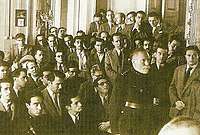1934 Thrace pogroms
The 1934 Thrace pogroms (Turkish: Trakya Olayları) refers to a series of violent attacks against Jewish citizens of Turkey in June and July 1934 in the Thrace region of Turkey. According to Corry Guttstadt, a "crucial factor" behind the events was the 1934 Turkish Resettlement Law passed by the Turkish Assembly on 14 June 1934.[1][2]
| 1934 Thrace pogroms | |
|---|---|
| Location | Trakya, Turkey |
| Date | June-July 1934 |
| Target | Property of the Jewish population of the city. |
| Deaths | Unknown |
History

The pogroms occurred in Tekirdağ, Edirne, Kırklareli, and Çanakkale, and were motivated by anti-Semitism.[3][4][5] Some have argued the acts were initiated by the articles produced by Pan-Turkist ideologists like Cevat Rıfat Atilhan and Faik Kurdoğlu in Millî İnkılâp [6] (National Revolution) magazine and Nihâl Atsız[6][7] in Orhun magazine.
It was followed by vandalizing of Jewish houses and shops. The tensions started in June 1934 and spread to a few other villages in Eastern Thrace region and to some small cities in Western Aegean region. At the height of violent events, it was rumoured that a rabbi was stripped naked and was dragged through the streets shamefully while his daughter was raped. Over 15,000 Jews had to flee from the region.[2]
The government of Mustafa Kemal failed to stop the pogrom.[8] In the context of the 1934 Turkish Resettlement Law, foreign diplomats of the time saw the government as implicitly supporting the Thrace pogrom in order to facilitate the relocation of the Jewish population.[9][2] Haaretz reports that according to the historian Corry Guttstadt, “the Turkish authorities had apparently opted for the strategy of putting the Jews under such pressure with boycott activities and anonymous threats ‘from the population’ that they would leave the area ‘voluntarily.’” Further, according to historian Rifat Bali that the incitement against Jews was common in the press at the time and this contributed to the violence.[10]
References
- "Pogroms to the Jews for the "Secular Democratic" of Turkey - Part I". Yekta Uzunoglu. Retrieved 2018-07-05.
- Guttstadt, Corry (2013). Turkey, the Jews, and the Holocaust. Cambridge University Press. pp. 65–66. ISBN 9780521769914. OCLC 870196866.
- "Pogroms to the Jews at the time of "Secular and Democratic" Turkey - Part III". Yekta Uzunoglu. Retrieved 2018-07-05.
- "Pogroms to the Jews for the "Secular Democratic" of Turkey – Part II". Yekta Uzunoglu. Retrieved 2018-07-05.
- Özkimirli, Umut; Sofos, Spyros A (2008). Tormented by history: nationalism in Greece and Turkey. Columbia University Press. p. 167. ISBN 9780231700528. OCLC 608489245.
- Rifat Bali, 1934 Trakya Olayları, 2008
- "Nihal Atsız profile (in Turkish)". Archived from the original on 2015-10-02. Retrieved 2020-05-16.
- AGE OF TERROR UNDERMINING TURKISH JEWS By HENRY KAMM and SPECIAL TO THE NEW YORK TIMES SEPT. 10, 1986
- Bayraktar, Hatiice (May 2006). "The anti-Jewish pogrom in Eastern Thrace in 1934: new evidence for the responsibility of the Turkish government". Patterns of Prejudice. 40 (2): 95–111. doi:10.1080/00313220600634238. ISSN 0031-322X.
- Green, David (5 June 2014). "1934: A Rare Kind of Pogrom Begins, in Turkey". Haaretz. Retrieved 29 September 2019.
Further reading
- Bayraktar, Hatice (May 2006), "The anti-Jewish pogrom in Eastern Thrace in 1934: new evidence for the responsibility of the Turkish government", Patterns of Prejudice, 40 (2): 95–111, doi:10.1080/00313220600634238